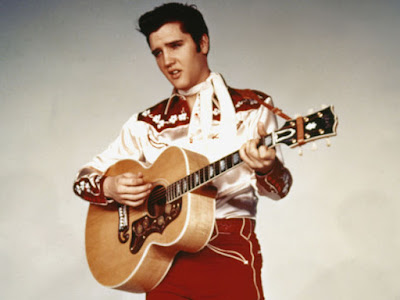 Elvis Presley and his Gibson J-200. |
How could you guys mess this up?
The most famous if not the greatest acoustic American folk instruments ever made were from the Gibson company, which was founded by Orville Gibson founded the company, circa1902 as the "Gibson Mandolin-Guitar Manufacturing Companyk Limited, in Kalamazoo, Michigan, to make mandolin-family instruments. Gibson brought unprecedented craftmanship in American folk string instruments. Gibson designed and manufactured high-end but affordable masterpieces. They weren't just instruments, but industry icons such as the F-5 Mandolin, Mastertone banjo, and the Les Paul electric guitar. These are the instruments that everyone else copies. Gibson also made a terrific acoustic guitars, though I wouldn't say that these guitars have the same iconic status as their other instruments, or at least the C. F. Martin company might want to contest it. There are thousands of other instruments made by Gibson.
 |
| Bill Monroe and his famous Gibson Mandolin. |
 |
| The Les Paul, with Les and lefty Paul McCartney demonstrating, is one of the most popular electric guitars of all time, |
 |
| The Gibson ES-350 semi-hollow-body is forever associated with Chuck Berry. |
 |
| Did you stupid accountants really destroy the quality of the B-25 by replacing the wood bridge with a plastic lookalike? Yes you did. |
I haven't worked in the field for years, but my impression is that the quality returned to Gibson and the other US manufacturers in the 1980s, after the MBA types were run off.
You can get higher quality instruments from very skilled small builders around the country, so professional musicians will always have options. Gibson's Chapter 11 adventure causes us to ask, whether there there room for high-end mass produced instruments from America? My heart tells me that there must be, though I confess I can't really evaluate the soundness of the business plan. I just can't believe that a company with this magnificent heritage could slide into bankruptcy.
Scuttlebutt is that the company got in trouble with their business units having to do with high-priced musical electronics, and this was apparently not sound. The company says it is going to return to its core competency to emerge from bankruptcy. That sounds like the right strategy, and I hope it works.
As a folk musician, even one with very modest proficiency like me, it's not just a blip on the business page. It's not just a company, but a major part of America's musical heritage. It's inconceivable that they can mess this up.
No comments:
Post a Comment